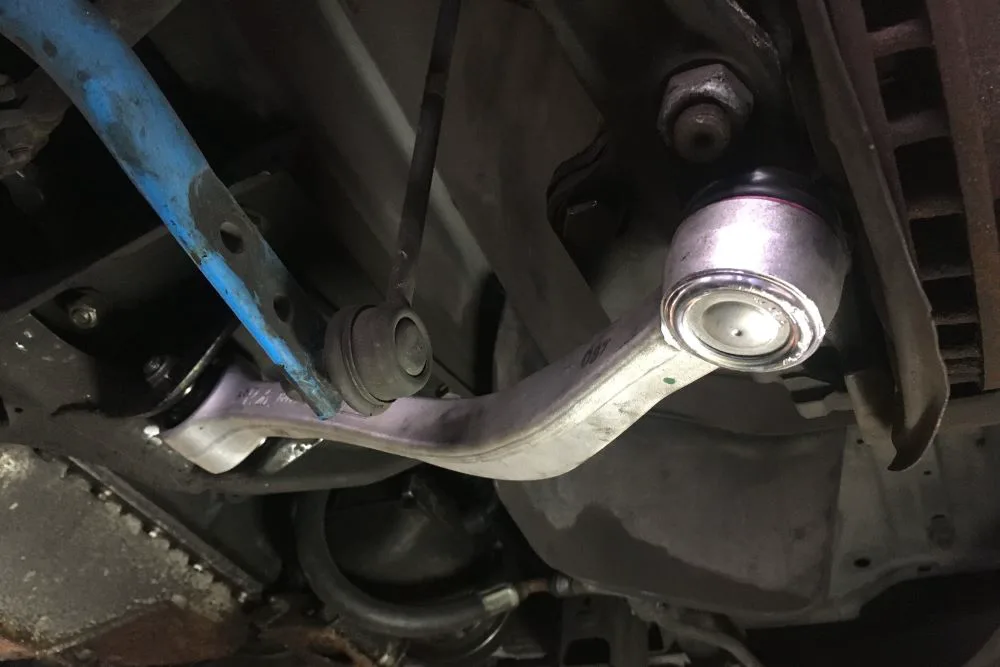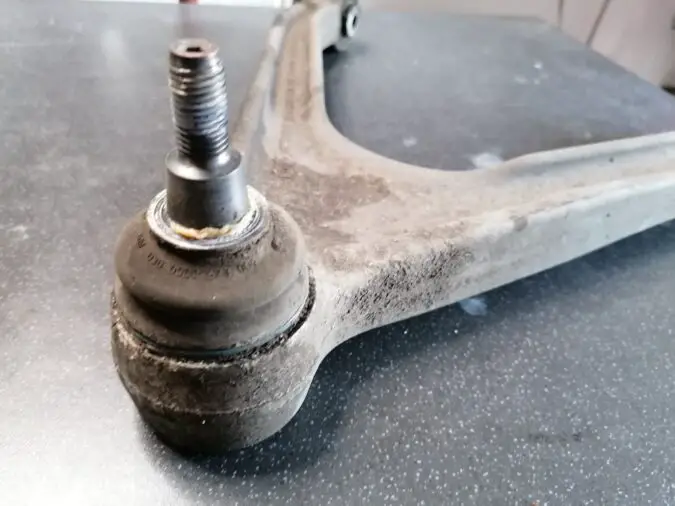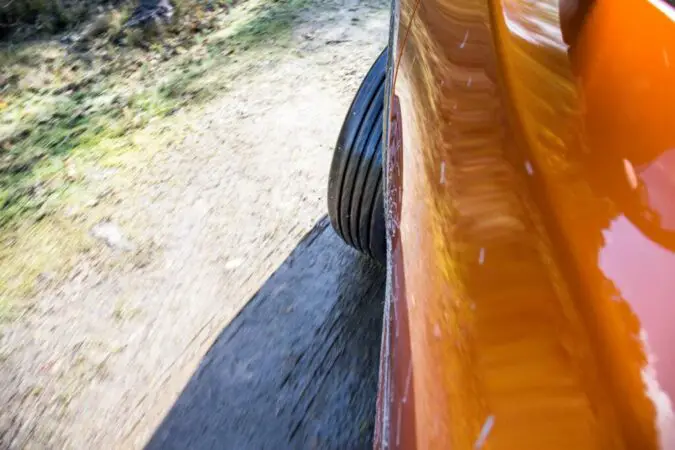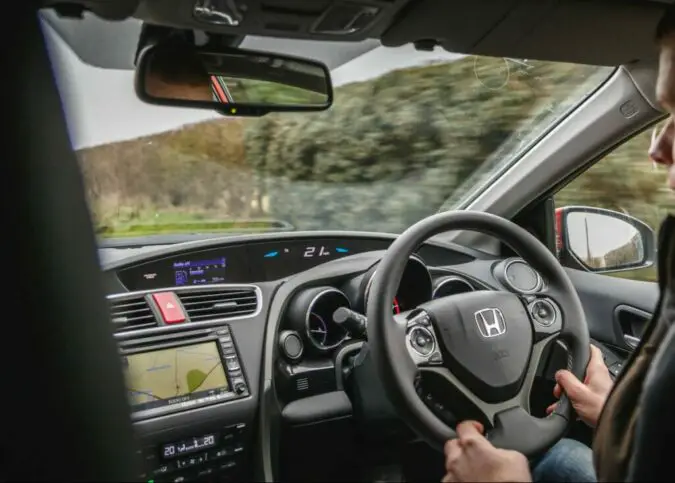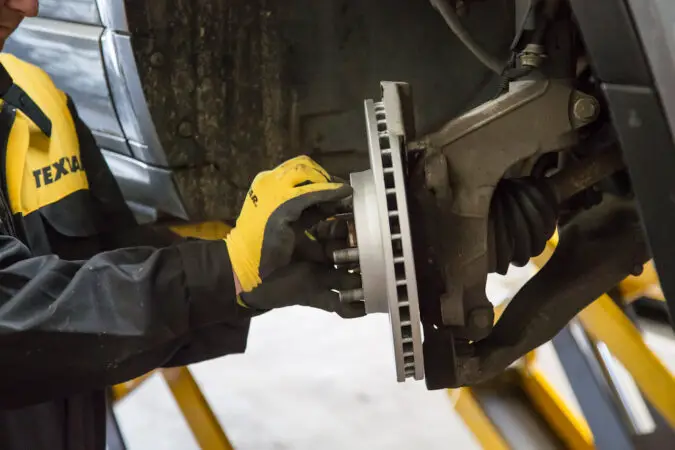Have you noticed that your bushings are gone and you are looking for the cost to replace the bushings? Well, if that is the case, then you are at the right place because this article will be all about bad control arm bushings. We will try to help you as much as we can when it comes to diagnosing and replacing these components.
- Upper Control Arm
- Lower Control Arm
- What Are Control Arm Bushings?
- Why Do These Bushings Fail?
- Symptoms Of Bad Bushings
- Diagnosing Control Arm Bushings
- Control Arm Bushing Replacement
- Cost Of Replacing The Bushings
- Final Conclusion
- Frequently Asked Questions (FAQs)
Doing the proper research before you go to a shop and replace the bushings should be your top priority. Why I’m saying this? Well, mainly because a lot of shops will try to rip you off for a simple job like this.
Replacing bushings is not something that’s all too difficult and with the right tools, it can be done quite quickly if the person is dedicated and want to sort out the problem as quickly as possible.
So, if someone is trying to charge you an arm and a leg for this type of work, you should rather find a different shop since there are cheaper alternatives. Sometimes purchasing a new control arm is cheaper than replacing these bushings. But more on that, later on in the article.
First, we are going to learn what is upper and lower control arms. Then we will cover more about the bushings as well as the symptoms that they produce when they wear out. As well as the causes for bad control arm bushings. Then we will dive into diagnosing and replacing these components and the cost to replace bushings. So, if you want to learn more, follow along.
Upper Control Arm
Now before we start discussing the cost to replace bushings, let’s take a look at what is a control arm in general. We will cover both control arms. First, we will discuss the upper control arm and then we will cover the lower control arm. So, let’s dive into the topic.
So, what is an upper control arm? Well, an upper control arm is simply a steel arm that connects the wheel knuckle on one side through the upper ball joint and the chassis of the vehicle from the other. The control arm basically keeps the vehicle on the road and makes sure that your wheels do not fall off.
What is interesting to note is that the upper control arm is usually included in double wishbone suspensions. This means that most of the cars out there do not have an upper control arm.
The only vehicles that usually have an upper control arm are older classic cars, pickup trucks that use ladder frames, or sports cars. So, if you don’t have this component, you should not panic. One less problem for you.
The important thing is that you should check the suspension and make sure that you have an upper control arm or not. But if you are running a regular passenger car, the chances of having one are really slim. Now let’s move on to the second type of control arm before we start discussing the cost to replace bushings.
Lower Control Arm
Now let’s cover the second type of control arm before we start discussing the cost to replace bushings. And this is the lower control arm.
A lower control arm in general is the same as the upper control arm. The lower control arm is a component that is connected to the chassis of the vehicle from one side and to the wheel knuckle on the other side.
The control arm is very rugged and a heavy-duty piece of metal. This is the component that keeps the wheel in a fixed position and does not allow it to wobble around and create bad control arm bushing symptoms.
What is important to note is that all cars nowadays are rocking lower control arms. Unlike the upper control arms that can be found only in certain vehicles. A lower control arm can be found in any vehicle out there that is rocking a double wishbone suspension or MacPherson strut suspension.
And most modern cars are running MacPherson struts nowadays. So, you get an idea of why these components are so essential. And how you can identify this component on the car?
Well, the control arm is also known as A-arm. This is the case because it resembles the letter A in uppercase. There are two connections on the chassis of the vehicle and the third connection is the lower ball joint which is connected to the wheel knuckle.
But what is the cost to replace bushings? Well, more on that, we are going to cover next. Now let’s learn something more about control arm bushings in general.
Control Arm Bushings
Now before we dive into the cost to replace bushings. Let’s first familiarize ourselves with the bushing and learn what is the lower control arm bushing, upper control arm bushing, and front control arm bushing. Are these components different?
Well, no, they are really the same design, the only different bushings are the rear control arm bushing which usually implements hydraulic fluid inside them. But what is the concept of a bushing?
Well, a bushing in simple terms is a component that is designed to serve as a buffer between two metal components.
Just imagine control arms with no bushings. First, they will produce a ton of noise while you drive the car. They will squeak all the time and driving a car would be really unpleasant.
Also, since there will be metal against metal action, there will be a great amount of wear on the control arm, as well as on the frame of the vehicle. So, you get the idea why the bushings are so essential.
And bushings are really simple parts. They are usually made out of rubber. While more expensive bushings are made out of polyurethane. A material that is far superior when compared to rubber.
As we mentioned, there are also oil-filled bushings that are usually mounted in the rear end. But on some cars, you can also find them in the front end. These are notorious for causing leaks.
Bushings are mounted only on the side of the frame and there are two of them for every control arm. As we noted previously, on the wheel side you only have an upper or lower ball joint, depending on the type of control arm. But what is the cost to replace bushings? More on that, in a bit.
What Causes Control Arm Bushings To Go Bad
Now before we start discussing the cost to replace bushings. Let’s first take a look at why bushings fail.
Knowing the failure points will really help you to determine whether or not you are struggling with failed bushings or not since these components on average tend to fail after many miles of use. So, let’s cover the most common causes of bushing failure,
Cost To Replace Bushings, Causes Of Failure #1: Wear And Tear
The first and most common cause of bushing failure is wear and tear. As you probably know, bushings are rubber components that wear after a certain amount of miles.
So, you cannot expect the bushings on your car to last forever. And especially if the car is more than 10 years old and the bushings have more than 60,000 miles.
If you have rubber bushings, then these probably already started to develop cracks on them and you should look for alternatives and replace them on time. Polyurethane bushings are much more durable and if you have the chance, we would recommend you replace them with these highly durable bushings.
Later on, we will learn more about the cost to replace bushings. Now let’s continue with the causes of failure of the bushings since there are a few more of them to cover.
Cost To Replace Bushings, Causes Of Failure #2: Age
The second most common reason why bushings fail and make you look for cost to replace bushings is age. Age greatly affects components like these.
So, if the bushings are old, you can expect them to start to develop cracks. Especially rubber bushings that are much more sensitive to cracking.
If the bushings are full of oil, like some carmakers make them, then they can also start to develop leaks and leak out.
And once the bushing leaks out, you will no longer have properly working bushings. So, it is really important that you check them out and make sure that they are not all cracked out and falling apart.
As we mentioned previously, polyurethane bushings are not very prone to conditions like in this case. So, they are a really good alternative when it comes to replacement. But what is the cost to replace bushings? More on that in a bit.
Cost To Replace Bushings, Causes Of Failure #3: Driving On Uneven Terrain
The next two causes for bad bushings are more related to the driving style. So, if you like to drive off-road. One of the things that you want to upgrade first is the control arm bushings. Why is this the case?
Well, if you use old rubber bushings, there is a high chance that your suspension will fail. Off-road conditions require polyurethane bushings that are really tough and are practically designed to run on these uneven surfaces.
This is why if you drive off-road too often and your bushings fail all of a sudden, then this might be the reason behind this problem. So, learn the cost to replace bushings and replace them before the problem becomes more serious and you damage the frame of the car. Now let’s move on to the last cause.
Cost To Replace Bushings, Causes Of Failure #4: Racing
And the last cause why bushings fail is probably racing. If you are one of those folks who want to take their car on the local track on Sunday, then you might want to make sure that these components are in good condition.
Also, another tip would be to upgrade them for aftermarket parts that are designed for heavy-duty applications such as this.
As well as not to forget to change them often. Mainly because suspension components wear quite a bit more on the track than compared to the standard commuting to work. But what is the cost to replace bushings? More on that in a bit after we cover the bad control arm bushing symptoms.
Symptoms Of Bad Control Arm Bushings
So, we have covered the causes of bad bushings. Now let’s move on and cover the bad control arm bushing symptoms.
Knowing the symptoms will really help you out when it comes to tackling this problem on your car. Each component, when it starts to fail, it develops some symptoms. So, knowing these symptoms is beneficial for you as an owner to be able to sort out the problem a lot quicker and learn the cost to replace bushings. So, let’s cover the main symptoms in the following chapters.
Cost To Replace Bushings, Symptoms #1: Clunking Noises
The first symptom associated with bad control arm bushings is the clunking noises that will develop when you drive the car.
These sounds can also resemble loud banging in some cases. Basically, this is a situation when the bushing is not doing its job anymore and the control arm is banging on the frame of the vehicle.
And frankly, this is something to avoid. This symptom is a red alert that will instantly tell you that you have a problem and this problem needs solving ASAP.
The clunking noises are probably the worst when you go over potholes or over bumps. The louder it gets, the worse the problem is. Just learn more about the cost to replace bushings and replace them before the problem becomes even greater.
Cost To Replace Bushings, Symptoms #2: Vibrations On The Steering Wheel
The next in our list of symptoms of bad bushings is the problem with vibrations. When the bushings are too worn out, you will also feel this inside of the cabin.
So, if you start noticing that the steering wheel is shaking and producing vibrations, for example at higher speeds, then this is a clear sign that something on the suspension is probably worn out and needs to be replaced.
The problem needs to be diagnosed and if you determine that the bushings are the ones to blame, just replace them with new ones and call it a day. More on the replacement, we will cover later on in the article.
Cost To Replace Bushings, Symptoms #3: Steering Wheel Wander
The next symptom in our list of symptoms of bad bushings is the steering wheel wander. When bushings are not tight and hold the control arms well, there could be some play and looseness in the wheels.
And the steering wheel could be difficult to keep straight. A car with bad suspension components often wants to wander around.
So, if you release the steering wheel for half a second while you drive and the wheel immediately pulls on one side, then this could mean that there is a problem with the bushings.
This is a quick test that you can pull off and the test really tells quite a lot. So, if the wheel pulls, then this requires your immediate attention. Now let’s move on to the next symptom before we cover the cost to replace bushings.
Cost To Replace Bushings, Symptoms #4: Uneven Tread Wear
The next symptom in our list of symptoms of bad control arm bushings is uneven tread wear. So, what is uneven tread wear?
Well, uneven tread wear is the situation when your tires do not wear evenly. They can wear on the inside, or outside. They can also feather out and wear in all different ways that you don’t want them to.
So, if you notice something like uneven tread wear on a tire, you need to act quickly and sort out the problem as soon as possible because it could get worse and you could end up with a puncture. And when it comes to high speeds, you definitely don’t want to suffer a puncture. So, learn the cost to replace bushings and replace them.
Cost To Replace Bushings, Symptoms #5: Car Unstable While Braking
And the last symptom in our list of bad control arm bushings is the situation when the car loses stability under heavy braking.
So, if the car starts to wander to the right or to the left under heavy braking and reacts strangely. Then you want to see what is going on with the suspension components.
Since some of them could go bad and cause the car to pull to the left or right under heavy braking. But how you can check the suspension on your car? Well, more on that, we are going to cover next before we start learning the cost to replace bushings.
How To Check Control Arm Bushings
Now before we dive into the cost to replace bushings, let’s first cover the diagnostics process. How you can tell that you have bad bushings on your car?
Well, the first thing to note is the symptoms. If you hear a clunk while driving on an uneven road, or possibly the steering wanders around. You might want to check what is happening underneath the car.
You will locate these bushings right on the frame where the control arm bolts on the frame. If the bushings are all cracked or leaking, then you definitely want to replace them.
If you are not sure about the condition, you might want to insert a pry bar between the frame and the control arm and give it a wobble. So, if the control arm wobbles, then the bushings are worn out. But what is the cost to replace bushings? More on that in a bit.
Control Arm Bushing Replacement
Another thing that we would like to cover before we dive into the cost to replace bushings is the replacement process. How it is done?
Well, replacing bushings is not easy if you don’t have the tools needed. So, in order to replace them, you will need to have a press to squeeze them out from the position.
On some applications, they even recommend replacing the control arm completely and installing a new one with new bushings. But more on the process, you can check in the video above.
Control Arm Bushing Replacement Cost
So, what is the cost to replace the bushings on your vehicle? Well, the answer to this question really depends on the make and model. As well as the type of bushings. Since some vehicles use bushings that are filled with oil that can be rather expensive. But overall, it is not an expensive job to do.
The parts alone cost between $80 and $195 depending on the type of bushings that you are running. Also, the labor is usually somewhere around $200 if you do both sides.
So, overall, you can expect to pay anywhere between $300 and $500 to replace the bushings on your car. While doing so, we would also recommend you fix other suspension problems as well as perform a wheel alignment.
Wheel alignment is crucial in order for the new parts to work. This job will also cost you $60 to $80. There are some factors to consider when accounting for the cost to replace your bushings…
1. Type of Vehicle
Different vehicle makes and models require unique bushings. A luxury car might have pricier parts compared to a budget-friendly model. European imports, for instance, might need parts not readily available, raising the cost.
2. Quality of Bushings
There are multiple grades of bushings: standard, performance-oriented, and premium. While standard ones do the job, premium bushings last longer and offer a smoother ride but at a higher price.
3. Mechanic’s Labor Rate
While most shops charge an hourly rate, it can vary based on location. Urban areas, given their higher living costs, might have more expensive services compared to suburban or rural places.
4. Additional Repairs
As previously touched upon, while fixing the bushings, addressing other suspension issues is wise. This may inflate the cost, but ensures a long-lasting and efficient fix.
5. Independent Garage vs. Dealership
Dealerships typically charge more than independent garages. While they offer specialized services, independent mechanics can provide quality work for less.
6. Price Estimates and Real-world Examples
Sedan:
For a typical sedan, like a Honda Accord, parts could cost around $100. Add labor and you might look at a total of $325, including wheel alignment.
SUV:
A larger vehicle, such as a Toyota Highlander, might have parts costing around $130. The total price, factoring in labor, could be around $400.
Luxury Car:
Taking a BMW as an example, premium parts might push the price to $190. With labor, the total might hover around $475, plus alignment.
Cost To Replace Bushings: In Conclusion…
In this article, we have covered quite a bit when it comes to control arm bushings. We learned what is the lower and upper control arms, as well as the bushings and their purpose.
Then we covered the main causes why bushings tend to fail, as well as the symptoms that these components produce. Lastly, we learned how you can replace them and the cost to replace bushings.
Cost To Replace Bushings: Frequently Asked Questions (FAQs)
Now let’s answer some frequently asked questions.
What Does A Lower Control Arm Do
The lower control arm is also known as A-arm. This component basically holds the wheel and other suspension components in a fixed position. Without a control arm, the car would simply crumble down to the ground.
How To Tell If Control Arm Is Bad
Usually, control arms do not go bad. The components that go bad are the rubber bushings and ball joint that are on the control arm. Sometimes though, the control arm could get bent. And if you notice that the wheel is misaligned, then you definitely have a bad control arm.
What Are Bushings On A Car
Bushings are rubber components that serve as a buffer between two metal components. For example the control arm and the frame of the car. Each control arm has to have bushings in order for the control arm not to damage the frame.
How Long Do Control Arm Bushings Last
Usually, they last for more than 60,000 miles with no problem. Even though some of the more modern fluid bushings tend to leak earlier if they are low-quality parts.
How To Check Control Arm Bushings
You can check by observing the undercarriage of the car. If the bushings have cracks on them or possible leaks of fluid, then you definitely have bad bushings. You can also get a pry bar and test the control arm to see if it wobbles around.
How Much Should It Cost To Replace Control Arm Bushings
Replacing this component is not the cheapest thing since they are rather difficult to remove. The parts usually go between $80 and $200. While the labor is between $150 to $200.

